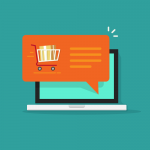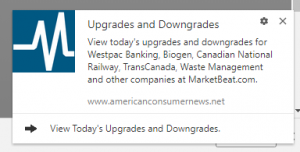 One of the best ways to build a business in this decade is to capture the attention of an audience and then rent that attention to advertisers that want to talk to your audience. We have done this with MarketBeat by earning the attention of 575,000 individual investors that have subscribed to our daily email newsletter. We then sell placements in our daily newsletter to advertisers for $2.00 to $3.00 per click. Owning the attention of an audience is serious business and can result in serious profits. MarketBeat made $1.8 million in email ad placements in 2017 and we are now implementing the same strategy using a new technology called web push notifications.
One of the best ways to build a business in this decade is to capture the attention of an audience and then rent that attention to advertisers that want to talk to your audience. We have done this with MarketBeat by earning the attention of 575,000 individual investors that have subscribed to our daily email newsletter. We then sell placements in our daily newsletter to advertisers for $2.00 to $3.00 per click. Owning the attention of an audience is serious business and can result in serious profits. MarketBeat made $1.8 million in email ad placements in 2017 and we are now implementing the same strategy using a new technology called web push notifications.
Websites can now send rich browser notifications to anyone that opts in to receive them. These notifications, known as web push notifications, appear in the lower right of your screen. They are currently supported by Chrome, Firefox, Safari, Android and soon Microsoft Edge. The best part of using this technology is that users will receive your notifications whether or not they’re on your website. If a user’s web browser is open, they will receive your notification. There are several services that enable website owners to use push notifications on their websites including OneSignal (which we use) and PushCrew.
Here is an example of a daily notification that we send out when new analysts’ recommendations are available:

While web push notifications have been around for more than four years, they are now just achieving widespread usage. They are still not supported by Microsoft Edge or Safari on iPhone and iPad. What opt-ins look like and how notifications are presented to users are still evolving. It’s early innings for web push notifications, but I am incredibly bullish on the technology. I believe over the next two to three years, web push notifications could become a revenue stream for MarketBeat that is on par with email.
Push Notifications – The Next Big Ad Platform?
We first added web push notifications to our network of financial news websites in late 2016. Since then, we’ve attracted approximately 175,000 individuals that have opted in to receiving push notifications from our website. By signing up for push notifications, they’ll receive a browser notice whenever we publish new content or make new data available on our website. They’ll also receive relevant notifications for related content from our advertisers, who pay a fixed fee per click on notifications we send on their behalf.
When we first tried to monetize our push notification list, advertisers weren’t interested because they weren’t familiar with the technology. We eventually gave a few of our best advertisers a free campaign against our web push list to see what the results were like. Advertising to our browser notification list worked incredibly well. Our users had great engagement rates with our advertiser’s content and we are now effectively sold out on our push notification inventory. We have 22 push campaigns in queue and it would take 3-4 weeks sending 4 advertiser notifications each day just to clear out the current campaign demand. These campaigns are working so well that an audience that advertisers weren’t interested in 18 months ago has turned into a $50,000 per month revenue stream for MarketBeat.
I can’t say for certain why advertisements toward an audience of web push notification subscribers works so well (even better than email), but it may have something to do with the fact that users that click on notifications are already surfing the web when an advertiser’s notification appears. They also don’t look like every other banner ad on the web, which results in them getting higher click-through rates. Since you have a generally good understanding of the type of people that subscribe to notifications to your list, you can also tailor ad placements toward their interests and how they think.
Best Practices for Push Notifications in 2018
During the last 12 months, we’ve sent more than 1,000 browser notifications to our growing audience. In total, we were able to generate more than 1.5 million clicks back to our website or to the websites of our advertisers. We’ve read through all the technical specifications for browser notifications and have tested pretty much every API option that OneSignal makes available to us to customize notifications we send.
Here are some best practices we have picked up during the last 18 months:
- Always Use the Native Opt-In – Companies like OneSignal and PushCrew provide two different types of opt-ins that allow users to receive push notifications. There’s an HTML and JavaScript opt-in that appear at the top center of the screen that appears on most websites (see example). This is known as a non-native opt-in and requires two clicks for someone to start receiving notification. There is also an opt-in mechanism built into the web-browser that is referred to as a native opt-in (see example). Many websites use a non-native opt-in because it doesn’t require your website to run using a secure connection (HTTPS). In my experience, using the one-step native opt-in results in dramatically higher opt-in rates. One report suggested that sites using the native browser opt-in can collect as many as seven times the number of opt-ins as the non-native opt-in.
- Preview Your Notifications Before Sending – Every web browser renders push notifications a little bit differently and includes a different subset of features included in the technical specifications for web push notifications. For example, you can include calls to action in Chrome, but can’t in Safari. Notifications on Chrome will render differently if you are on Mac or on Windows. Microsoft Edge’s push notifications will appear in the Windows Action Center when they make push notifications available in the next version of Windows 10. There are some general design rules, such as keeping your title to under 30 characters, but you really need to test your notifications in a real live web-browser to see what they will look like to your users. That way notifications will appear as you intended them to and won’t get cut off mid-sentence.
- Send Four or Five Notifications Per Day – In order to maximize clicks back to our website, I’ve found that the right balance (at least for our audience) is to send four or five notifications spread out equally throughout the day. We might send notifications at 7:00 AM, 10:00 AM, 1:00 PM, 4:00 PM and again at 7:00 PM. We recognize that not everyone will see every notification, but everyone will probably see one or two notifications if we spread them out across the day. You can also specify that you want notifications to be sent to a user based on their time zone; that way you’re not sending them notifications in the middle of the night if they live in a different part of the world.
- Use Action Buttons to Increase Click-Through Rates – We include a call-to-action in every push notification that we send out in the form of an action button. This is the “View Today’s Upgrades and Downgrades” link in the example above. This gives a second opportunity to instruct your users to act and gives them something obvious to click on. This feature is currently only supported in Chrome and isn’t supported in Firefox or Safari.
- Use Large Images – Chrome on Windows and Android allows you to send a 720×480 rectangular image (see example) that appears with your push notification. These make your notifications larger and easier to click. They also provide you more screen real estate to communicate your message to your audience.
- Use Custom Icons – Every web push notification sent includes a small square image that you can use to sell your content. If you don’t specify an image, your default image (likely your logo) will appear. I recommend including a unique image with each notification to maximize engagement and click-through rates.
- Don’t Have Web Visitors to Opt In? Buy them. The number of web push subscribers you will attract depends largely on the amount of web traffic you receive. MarketBeat gets between 3 and 5 million page views each month, so it was easy for us to attract 175,000 web push subscribers. However, about 10% of these opt-ins didn’t come from our website. We have a partner who collects push notifications for MarketBeat on their website and we pay them a fixed CPM to run a web push opt-in that we control. We can then send news and content for MarketBeat and MarketBeat’s advertisers to users that opted in to their website.
Hopefully these best practices will help you grow your audience of web push subscribers faster and will help you better leverage your web push audience. If you have any best practices to add to this list, please share them in the comments below.
